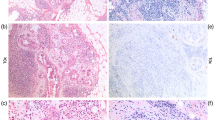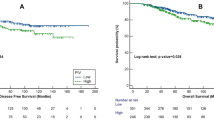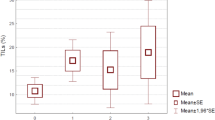Abstract
This study was undertaken to determine the absolute and relative value of blood vessel invasion (BVI) using both factor VIII-related antigen and elastica van Gieson staining, proliferating cell nuclear antigen (PCNA), p53, c- erb B-2, and conventional prognostic factors in predicting relapse-free survival (RFS) and overall survival (OS) rates associated with long-term survival in Japanese patients with node-negative breast cancer. Two hundred patients with histological node-negative breast cancer were studied. We investigated nine clinicopathological factors, including PCNA, p53, c- erb B-2 using permanent-section immunohistochemistry, clinical tumour size (T), histological grade (HG), mitotic index (MI), tumour necrosis (TN), lymphatic vessel invasion (LVI) and BVI, followed for a median of 10 years (range 1–20). Twenty-one patients (10.5%) had recurrence and 15 patients (7.5%) died of breast cancer. Univariate analysis showed that BVI, PCNA, T, HG, MI, p53, c- erb B-2 and LVI were significantly predictive of 20-year RFS or OS. Multivariate analysis showed that BVI (P = 0.0159, P = 0.0368), proliferating cell nuclear antigen (PCNA) (P = 0.0165, P = 0.0001), and T (P = 0.0190, P = 0.0399) were significantly independent prognostic factors for RFS or OS respectively. BVI, PCNA and T were independent prognostic indicators for RFS or OS in Japanese patients with node-negative breast cancer and are useful in selecting high-risk patients who may be eligible to receive strong adjuvant therapies. © 2000 Cancer Research Campaign
Similar content being viewed by others
Article PDF
Change history
16 November 2011
This paper was modified 12 months after initial publication to switch to Creative Commons licence terms, as noted at publication
References
Andrulis IL, Bull SB, Blackstein ME, Sutherland D, Mak C, Sidlofsky S, Pritzker KP, Hartwick RW, Hanna W, Lickley L, Wilkinson R, Qizilbash A, Ambus U, Lipa M, Weizel H, Katz A, Baida M, Mariz S, Stoik G, Dacamara P, Strongitharm D, Geddie W and McCready D (1998) neu/erbB-2 amplification identifies a poor-prognosis group of women with node-negative breast cancer. Toronto Breast Cancer Study Group. J Clin Oncol 16: 1340–1349
Barbareschi M, Caffo O, Veronese S, Leek RD, Fina P, Fox S, Bonnzanini M, Girlando S, Morelli L, Eccher C, Pezzella F, Doglioni C, Palma PD and Harris A (1996) Bcl-2 and p53 expression in node-negative breast carcinoma: a study with long-term follow-up. Hum Pathol 27: 1149–1155
Bettelheim R, Mitchell D and Gusterson BA (1984) Immunocytochemistry in the identification of vascular invasion in breast cancer. J Clin Pathol 37: 364–366
Bianchi S, Paglieranti M, Zampi G, Cardona G, Cataliotti L, Bonardi R, Zappa M and Ciatto S (1993) Prognostic value of proliferating cell nuclear antigen in lymph node-negative breast cancer patients. Cancer 72: 120–125
Bloom HIJ and Richardson WW (1957) Histologic grading and prognosis. Br J Cancer 11: 359–377
Clahsen PC, van de Velde CJ, Duval C, Pallud C, Mandard AM, Delobelle-Deroide A, van den Broek L, Sahmound TM and van de Vijver MJ (1998) P53 protein accumulation and response to adjuvant chemotherapy in premenopausal women with node-negative early breast cancer. J Clin Oncol 16: 470–479
Clayton F (1991) Pathologic correlates of survival in 378 lymph node-negative infiltrating ductal breast carcinomas. Mitotic count is the best single predictor. Cancer 68: 1309–1317
Clemente CG, Boracchi P, Andreola S, Del Vecchio M, Veronesi P and Rilke FO (1992) Peritumoral lymphatic invasion in patients with node-negative mammary duct carcinoma. Cancer 69: 1396–1403
Cox DR (1972) Regression models and life tables. J. R. Stat.Soc B 34: 187–202
Davis BW, Gelber RD, Goldhirsch A, Hartmann WH, Locher GW, Reed R, Golouh R, Save-Soderbergh J, Holloway L, Russel I and Rudenstam M (1986) Prognostic significance of tumor grade in clinical trials of adjuvant therapy for breast cancer with axillary lymph-node metastasis. Cancer 58: 2662–2670
de Mascarel I, Bonichon F, Durand M, Mauriac L, MacGrogan G, Soubeyran I, Picot V, Avril A, Coindre JM and Trojani M (1998) Obvious peritumoral emboli: an elusive prognostic factor reappraised. Multivariate analysis of 1320 node-negative breast cancers. Eur J Cancer 34: 58–65
Dittadi R, Brazzale A, Mione R, Di Fresco S, Gatti C, Vinante O, Bassan F, Nascimben O and Gion M (1997) Quantitative chemiluminescent immunoassay of p53: prognostic significance in 220 node-negative breast cancer tissue. Anticancer Res 17: 4691–4696
Eppenberger Kueng W, Schlaeppi JM, Roesel JL, Benz C, Mueller H, Matter A, Zuber M, Luescher K, Litschgi M, Schmitt M, Foekens JA and Eppenberger-Castori S (1998) Marker of tumor angiogenesis and proteolysis independently define high- and low-risk subsets of node-negative breast cancer patients. J Clin Oncol 16: 3129–3136
Fisher B, Dignam J, Mamounas EP, Castantino JP, Wickerham DL, Redmond C, Wolmark N, Dimitrov NV, Bowman DM, Glass AG, Atkins JN, Abramson N, Sutherland CM, Aron BS and Margolese RG (1996) Sequential methotrexate and fluorouracil for the treatment of node-negative breast cancer patients with estrogen-receptor-negative tumors: eight-year results from national surgical adjuvant breast and bowel project (NSAB) B-13 and first report of findings from NSABP B-19 comparing methotrexate and fluorouracil with conventional cyclophosphamide, methotraxate, and fluorouracil. J. Clin Oncol 14: 1982–1992
Fox SB, Leek RD, Smith K, Hollyer J, Greenall M and Harris AL (1994) Tumor angiogenesis in node-negative breast carcinomas – relationship with epidermal growth factor receptor, estrogen receptor, and survival. Breast Cancer Res Treat 29: 109–116
Gasparini G, Weidner N, Bevilacqua P, Maluta S, Palma PD, Caffo O, Barbareshi M, Baracchi P, Marubini E and Pozza F (1994) Tumor microvessel density, p53 expression, tumor size, and peritumoral lymphatic vessel invasion are relevant prognostic markers in node-negative breast carcinoma. J Clin Oncol 12: 454–466
Gasparini G, Toi M, Gion M, Verderio P, Dittadi R, Hanatani M, Matsubara I, Vinante O, Bonoldi E, Boracchi P, Gatti C, Suzuki H and Tominaga T (1997) Prognostic significance of vascular endothelial growth factor protein in node-negative breast cancer. J Natl Cancer Inst 89: 139–147
Haagensen CD (1986) The relation of age to the frequency of breast carcinoma. In: Disease of the Breast, 3rd edn, Haagensen CD (ed); pp. 402–407, WB Saunders: Philadelphia
Harbeck N, Dettmar P, Thomssem C, Henselmann B, Kuhn W, Ulm K, Janicke F, Hofler H, Graeff H and Schmitt M (1998) Prognostic impact of tumor biological factors on survival in node-negative breast cancer. Anticancer Res 18: 2187–2197
Horak ER, Leek R, Klenk N, Lejeune S, Smith K, Stuart N, Greenall M, Stepniewska K and Harris AL (1992) Angiogenesis, assessed by platelet/endothelial cell adhesion molecule antibodies, as indicator of node metastases and survival in breast cancer. Lancet 340: 1120–1124
Isola JJ, Helin HJ, Helle MG and Kallioniemi O (1990) Evaluation of cell proliferation in breast carcinoma: comparison of Ki-67 immunohistochemical study, DNA flow cytometric analysis, and mitotic count. Cancer 65: 1180–1184
Iwaya K, Tsuda H, Fukutomi T, Tsugane S, Suzuki M and Hirohashi S (1997) Histologic grade and p53 immunoreaction as indicators of early recurrence of node-negative breast cancer. Jpn J Clin Oncol 27: 6–12
Kaplan EL and Meier P (1958) Non-parametric estimation from incomplete observations. J Am.Stat Assoc 53: 457–481
Kato T, Kimura T, Muraki H, Miyakawa R, Tanaka S, Kamio T, Yamamoto K, Hamano K, Aiba M and Kawakami M (1996) Clinicopathological features associated with long-term survival in node-negative breast cancer patients. Surg Today 26: 105–114
Kato T, Kimura T, Ishii N, Akiho F, Yamamoto K, Kameoka S, Nishikawa T and Kasajima T (1999) The methodology of quantitation of microvessel density and prognostic value of neovascularization associated with long-term survival in Japanese patients with breast cancer. Breast Cancer Res Treat 53: 19–31
Lampe B, Hantschmann P and Dimpfl T (1998) Prognostic relevance of immunohistology, tumor size and vascular space involvement in axillary node negative breast cancer. Arch Gynecol Obstet 261: 139–146
Lauria R, Perrone F, Carlomagna C, De Laurentis M, Morabit A, Gallo C, Varriale E, Pettinato G, Panico L, Petrella G, Bianco AR and De Placido S (1996) The prognostic value of lymphatic and blood vessel invasion in operable breast cancer. Cancer 76: 1772–1778
Lee AKC, Delellis RA, Silverman ML, Heatley GJ and Wolfe HJ (1990) Prognostic significance of peritumoral lymphatic and blood vessel invasion in node-negative carcinoma of the breast. J Clin Oncol 8: 1457–1465
Mansour EG, Gray R, Shatila AH, Osborne CK, Tormey DC, Gilchrist KW, Cooper MR and Falkson G (1989) Efficacy of adjuvant chemotherapy in high-risk node-negative breast cancer. N Engl J Med 320: 485–490
Mantel N (1966) Evaluation of survival data and two new rank order statistics arising in its consideration. Cancer Chemother Rep 50: 163–170
Martin SA, Perez-Reyes N and Mendelsohn G (1987) Angioinvasion in breast carcinoma. An immunohistochemical study of factor VIII-related antigen. Cancer 59: 1918–1922
McGuire WL, Tandon AK, Allred DC, Chamness GC and Clark GM (1990) How to use prognostic factors in axillary node-negative breast cancer patients. J Natl Cancer Inst 82: 1006–1015
Molina R, Segui MA, Climent MA, Bellmunt J, Albanelll J, Fernandez M, Filella X, Jo J, Gimenez N, Iglesias E, Miralles M, Alonso C, Peiro G, Perez-Pianol E and Ballesta AM (1998) p53 oncoprotein as a prognostic indicator in patients with breast cancer. Anticancer Res 18: 507–511
O’Malley FP, Saad FZ, Kerkvliet N, Dolg G, Stitt L, Ainsworth P, Hundal H, Chambers AF, Turnbull DI and Bramwell V (1996) The predictive power of semiquantitative immunohistochemical assessment of p53 and c- erb B-2 in lymph node-negative breast cancer. Hum Pathol 27: 955–963
Railo M, Lundin J, Haglund C, von Smetten K, von Boguslawsky K and Nordling S (1997) Ki-67, p53, Er-receptors, ploidy and S-phase as prognostic factors in T1 node negative breast cancer. Acta Oncol 36: 369–374
Rosen PP, Groshen S, Saigo PE, Kinne DW and Hellman S (1989) A long-term follow-up study of survival in Stage I (T1N0M0) and Stage II (T1N1M0) breast carcinoma. J Clin Oncol 7: 355–366
Saigo PE and Rosen PP (1987) The application of immunohistochemical stains to identify endothelial-lined channels in mammary carcinoma. Cancer 59: 51–54
Sampat MB, Sirsat MV and Gangadharan P (1978) Prognostic significance of blood vessel invasion in carcinoma of the breast in women. J Surg Oncol 9: 623–632
Sears HF, Janus C, Levy W, Hopson R, Creech R and Grotzinger P (1982) Breast cancer without axillary metastases. Are there high-risk biologic subpopulations?. Cancer 50: 1820–1827
Sitonen SM, Kallioniemi OP and Isola JJ (1993) Proliferating cell nuclear antigen immunohistochemistry using monoclonal antibody 19A2 and a new antigen retrieval technique has prognostic impact in archival paraffin-embedded node-negative breast cancer. Am J Pathol 142: 1081–1089
Stemmermann GN, Catts A, Fukunaga FH, Horie A, Abraham M and Nomura Y (1985) Breast cancer in women of Japanese and Caucasian ancestry in Hawaii. Cancer 56: 206–209
Tandon AK, Clark GM, Chamnes GC, Chirgwin JM and McGuire WL (1990) Cathepsin D and prognosis in breast cancer. N Engl J Med 322: 297–302
van de Velde CJH, Gallager HS and Giacco GG (1986) Prognosis in node-negative breast cancer. Breast Cancer Res Treat 8: 189–196
Weigand RA, Isenberg WM, Russo J, Brennan MJ and Rich MA (1982) The breast cancer prognostic study associates: blood vessel invasion and axillary lymph node involvement as prognostic indicators for human breast cancer. Cancer 50: 962–969
Wright C, Angus B, Nicholson S, Sainsbury JRC, Cairns J, Gullick WJ, Kelly P, Harris AL and Horne CHW (1989) Expression c- erb B-2 oncoprotein: a prognostic indicator in human breast cancer. Cancer Res 49: 2087–2090
Wynder EL, Kajitani T, Kuno J, Lucas JC, De Palo A and Farrow J (1963) A comparison of survival rates between American and Japanese patients with breast cancer. Surg Gynecol Obstet 117: 196–200
Author information
Authors and Affiliations
Rights and permissions
From twelve months after its original publication, this work is licensed under the Creative Commons Attribution-NonCommercial-Share Alike 3.0 Unported License. To view a copy of this license, visit http://creativecommons.org/licenses/by-nc-sa/3.0/
About this article
Cite this article
Kato, T., Kimura, T., Miyakawa, R. et al. Clinicopathologic study associated with long-term survival in Japanese patients with node-negative breast cancer. Br J Cancer 82, 404–411 (2000). https://doi.org/10.1054/bjoc.1999.0934
Received:
Revised:
Accepted:
Published:
Issue date:
DOI: https://doi.org/10.1054/bjoc.1999.0934
Keywords
This article is cited by
-
Prognostic value of tumor necrosis based on the evaluation of frequency in invasive breast cancer
BMC Cancer (2023)
-
The pattern of prognostic and risk indicators among women with breast cancer undergoing modified radical mastectomy in Dar es Salaam, Tanzania
Infectious Agents and Cancer (2016)
-
Immunohistochemical detection improves the prognostic value of lymphatic and blood vessel invasion in primary ductal breast cancer
BMC Cancer (2014)
-
The combination of angiogenesis and blood vessel invasion as a prognostic indicator in primary breast cancer
British Journal of Cancer (2003)



